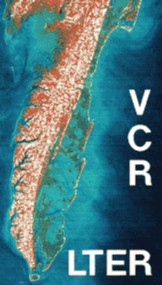 The Effects of Artificially Increased Tidal Inundation on High Marsh Productivity |

Miller, W. D., Anderson, I. C., Neubauer, S. C.
Department of Biology
|
 The Effects of Artificially Increased Tidal Inundation on High Marsh Productivity |

Miller, W. D., Anderson, I. C., Neubauer, S. C.
Department of Biology
|
Tidal inundation is a natural disturbance which occurs on all salt marshes. The frequency, duration, and volume of inundation can result in drastically different rates of photosynthesis and respiration by the flora in salt marshes. Marsh elevation may keep up with apparent sea level rise either by import of sediment or by biogenic accumulation of organic material within the marsh. On the high marsh of the Virginia Coast Reserve, there is little input of sediment; thus, most accretion occurs through biological means. At the VCR/LTER's site on the Eastern Shore of Virginia an experiment has been initiated to test the effects of increased tidal inundation on biological processes in the high marsh. These high marsh habitats are vegetated predominately by Spartina patens and Distichlis spicata and are the focus of a suite of studies to examine the role of tidal inundation on carbon and nitrogen biogeochemical cycling. The study described here utilizes in situ temperature controlled metabolic chambers to measure the biogenic flux of carbon dioxide in marsh habitats. Carbon dioxide concentrations were determined with a LiCor model 6252 infrared gas analyzer. This experimental design offers a more precise and accurate measure of marsh primary production and respiration than traditional biomass harvest techniques. Preliminary results thus far suggest that increased inundation frequency causes a significant decrease in sediment respiration rates. This study will continue in order to more fully determine the effects that altered hydroperiod have upon high marsh primary productivity.